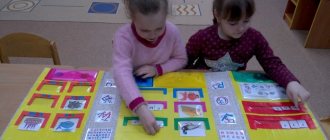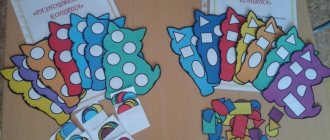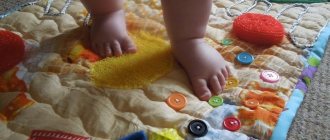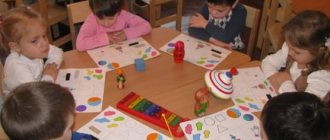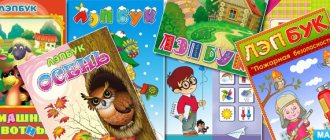Using a laptop in the work of a speech therapist
author: Kazbanova Svetlana Vladimirovna
Teacher - speech therapist MBDOU "Kindergarten No. 59 "Cinderella" Norilsk
Using a laptop in the work of a speech therapist
LAPTOP: COUNTRY OF GRAMMAR
Goal: To form in children the necessary readiness for learning to read and write, to consolidate and systematize children’s knowledge of letters (sounds)
Russian language.
Educational objectives
- mastering the concepts of “sound”, “letter”, “word”, “syllable”, “sentence” and introducing them into the active vocabulary;
- learning the skill of sound analysis of a word (determination of vowel and consonant sounds, sound quality by pairing, place of sound in a word, dividing a word into syllables);
- mastering and improving the technique of reading syllables and short words;
- the ability to correlate a spoken word with its sound composition in a schematic form;
Developmental tasks
- development of thought processes (comparison, simple comparison, analysis);
- activation of auditory and visual memory;
- implementation of a constant connection between literacy training and speech development, improving speaking skills;
- development of attentiveness and curiosity in students.
Educational tasks
- instilling a love for the Russian language, the beauty of the spoken word;
- stimulating the desire for communication;
- formation of skills of cooperation, independence, initiative.
The location of the material in the lapbook is divided into several zones:
- Cover – the alphabet of the Russian language in pictures and the definition of the concept “LETTER”
- The first spread is “SOUND HOUSES OF VOWELS AND CONSONANTS” and the definition of the concept “SOUND”. Sound houses have separate “apartments” for each sound with color and symbols.
Goal: Determine which group the sound being studied belongs to: vowel, hard consonant, soft consonant. When determining, children rely on their sensations: the position of the tongue in the oral cavity, tactile and vibration control, the presence of an air stream and its duration.
Let's remember: Sounds - we hear and pronounce sounds.
Vowel sounds are sounds during the pronunciation of which the air stream comes out freely, neither lips, nor teeth, nor tongue interfere with it, therefore vowel sounds can sing. They sing (voice, shout) and can sing any melody. For vowel sounds, we came up with “houses” in which they will live. We decided that vowel sounds would live only in red houses (red circles or squares).
Consonant sounds are sounds during which the air stream encounters an obstacle. It is either her lips, teeth, or tongue that prevent her from coming out freely. Some of them can sing (SSS, MMM,) but none of them can sing, but they want to sing. Therefore, they AGREE to be friends with vowels, with which they can also sing any melody (ma-ma-ma-...). That's why these sounds were called CONSONANT sounds. Consonant sounds are hard and soft.
Hard consonant sounds [P, B, T, D, M, K, G, ...] sound angry (firm) in words.
Soft consonant sounds [P', B', T', D', M'...] sound affectionately (softly) in words.
The sounds [Ш, Ж, Ц] are always hard, they do not have a “soft” pair.
The sounds [Ch, Shch, Y] are always soft, they do not have a “hard” pair.
Consonant sounds can be voiced and unvoiced - you can check this by tactile vibration (when pronouncing a sound, close your ears or put your palm to your throat: if it hums, it is a voiced sound, if it does not hum, it is deaf).
When the laptop is fully opened:
- Page "SYLLABLES". The purpose of these games: To teach merging sounds into syllables. Practice reading forward and backward syllables.
Page 4 “STAR TRAIL OF WORDS” - the last sound in a word is the beginning of the next word.
“SOUND SNAIL” - selection of words with a given sound. In parallel, work is underway to determine the location of the sound (beginning, middle, end)
Goal: To develop sound analysis skills, the ability to highlight the 1st, last sound in a word, and determine the location of the sound in a word. Practice the ability to distinguish by ear and name words that have a certain sound in the word.
Attention! Let us remember the “features” of the Russian language: at the end of a word, voiced consonants are deafened, and unstressed vowels change their sound. For example, “mushroom” [griP], “lump” [kamok], etc. Accordingly, after the word “mushroom” we look for the next word with the sound [P] - stick.
- page “SYLLABLE TRAIN”
Goal: Learning and consolidating the ability to divide words into syllables and determine the number of syllables in a word.
Book “HARD OR SOFT”
Purpose: Differentiation of sounds by hardness/softness.
Bird "SOUND"
Purpose: Exercise in determining the place of sound in a word (beginning, middle, end)
The book “THIS IS WHAT THEY ARE!” based on the work of A. Shibaev “The Letter Got Lost”
Goal: Development of phonemic hearing, phonemic perception. Activation of mental activity, development of visual-figurative thinking and elements of logical thinking, intelligence.
- PYRAMID page
Goal: Generalization and consolidation of acquired knowledge: laying out words, sound-letter analysis (drawing a diagram using colored chips); dividing a word into syllables and defining a stressed syllable (denotation by a conventional sign); composing sentences with words and drawing up sentence diagrams.
As options for “Choose a word”:
- to the word diagram,
- to the syllabic pattern,
Come up with a sentence with the word ... according to the sentence diagram.
GOOD LUCK AND CREATIVITY IN WORKING WITH THE “STAN GRAMMAR” GUIDE
mde
smartcapture
mde
mde
mde
smartcapture
mde smartcapture
mde
mde Using a laptop in the work of a speech therapist
Speech development is a complex, multifaceted process that is closely related to the formation and development of human mental processes.
Mastering the native language as a means and way of communication and knowledge is one of the most important acquisitions of a child. This problem is at the center of many modern studies. In the first years of life, speech first acts as a means of communication and designation, then it becomes a tool of thinking, expressing thoughts, and organizes human activity and behavior (L. S. Vygotsky, 1983; A. R. Luria, 1956, etc.
In recent years, there has been a decline in the level of speech development of preschool children. This is facilitated by a number of reasons, which include the deterioration of children’s health, the global decline in the level of speech culture in society, and the passivity and ignorance of parents in matters of children’s speech development, which most often manifests itself in the imbalance of family education in matters of speech development, which manifests itself either in the desire for early learning of written language at the expense of oral, or in an indifferent attitude towards it.
The participation of parents in the speech development of the child plays a colossal role.
In children with OSD, speech does not develop independently. The process of accumulation, selection of words and handling them in speech activity suffers (the dictionary is chaotic and unorganized). All this leads to a decrease in attention, memory, and cognitive processes of perception.
Speech formation is one of the main tasks of speech education of a preschooler, because plays a big role in the formation of personality. To develop a child’s speech, you should use various games, activities, manuals, and innovative technologies. In connection with the implementation of the Federal State Educational Standard for preschool educational institutions, teachers are looking for new approaches, ideas, and teaching methods in order to meet modern requirements for the education and upbringing of preschool children.
In the context of the implementation of the new Federal State Educational Standard (FSES), working with children with general speech underdevelopment and facing problems in their learning, a teacher-speech therapist has to look for aids that facilitate, systematize and guide the process of mastering new material. A speech therapist teacher must show mobility, variability and creativity in choosing educational technologies that will help each child show his interests and needs, and also involve his parents in the correction process.
Proper organization of education for children with special needs is a very difficult matter. Therefore, along with generally accepted techniques and principles, it is entirely justified to use original, creative methods, the effectiveness of which is obvious.
In my opinion, the introduction of new approaches to the development of preschoolers with special needs should not contribute to replacing traditional methods, but to expanding their capabilities. Therefore, in my work with such children I use both traditional and modern educational technologies, which I effectively use in joint activities with children, as well as with their parents.
One of such teaching aids for today's preschoolers is a lapbook or, in other words, a thematic or interactive folder. This folder collects material on a specific topic.
A laptop is interesting and useful because it is made jointly by an adult and children.
A laptop is a relatively new phenomenon; it is a folding book with pockets, doors, windows, tabs and moving parts, in which materials on one topic are placed. A laptop helps a child organize information on the topic being studied at will and better understand and remember the material (especially considering that the thinking of children in preschool age is visual and figurative in nature).
Lapbook literally translated from English means “knee book.” The laptop is a relatively new learning tool.
In children with speech disorders, speech does not develop independently. The process of accumulating words and using them in speech activity suffers. The path to correcting sound pronunciation is difficult and lengthy. As mentioned above, preschoolers in this category also suffer from cognitive processes: memory, attention, perception, thinking.
The solution to these problems is the use of a laptop in speech correction work.
This interactive folder allows you to:
· replenish children's vocabulary and expand the “semantic fields” of word meanings;
· speed up and make the process of automation and differentiation of sounds more attractive;
· form grammatical categories;
· develop coherent speech;
· form the psychological basis of speech;
· improve fine motor skills.
For us, a lapbook is a unique means of collaboration with children; it is an excellent way to consolidate and repeat material. By combining play, learning and education into one process, a lapbook makes it possible to build work on speech development with children with speech impairments, taking into account the individual characteristics of the child, to create conditions under which the child independently consolidates the acquired knowledge in the form of a game, and also, importantly, develops speech skills.
At the first stage, we studied the limited experience of domestic teachers on this topic using Internet resources.
At the second stage, based on the analysis of the studied materials, a test laptop was made. The children were interested in the lapbook. Our children have been familiar with laptops and netbooks since childhood. The word “lapbook” is consonant with these terms, which means that it also contains a lot of interesting and useful information. And the main thing is that you can touch, feel, explore all the pockets and envelopes!
At the third stage, together with the children, they began to develop and use their own lapbook: “Animals of Africa.” The making of a lapbook was preceded by thematic activities and games, discussion and assignments. The child remembers information, draws diagrams of the layout of games in a book, learns to plan, explore, and design. With such work, the lapbook really fulfills its role as a reinforcing, didactic and gaming aid.
It is not necessary for the child to complete all tasks at once. Many of them are designed for long-term work, studying additional information and conducting their own research. Therefore, you need to return to the lapbook more than once, which means playing and studying.
In addition to educational advantages, a lapbook can be perceived by preschoolers as a “treasure” to which it is interesting to return, leaf through and revise information, remembering it and accumulating it in their memory. Therefore, when the created “treasure” is demonstrated to peers, spontaneous discussions and debates occur, which help improve the assimilation of information, as well as the development of monologue and dialogic speech of children.
The use of a lapbook in speech therapy work with preschoolers with special needs as an independent teaching aid can be used in any preschool educational institutions. This technology touches on the current and sought-after topic of speech development in children with special needs and allows you to build a system of work on the development of the lexical and grammatical structure of speech, reveal children's initiative and organize effective cooperation with the family.
An important and integral part of the work to eliminate speech disorders in children is the close interaction of parents in matters of pathology and speech correction, their underestimation of the early detection of speech defects and timely intervention on them, incorrect and sometimes harmful attitudes regarding the speech of children, indicate the need for all stages of correction. Parental help is extremely important. Firstly, parental opinion is the most authoritative for the child, and secondly, only parents have the opportunity to daily consolidate the skills they are developing in the process of live, direct communication with their children.
Creating a lapbook is one of the types of joint interactive activities between adults and children. This is expressed in the fact that parents, together with their children, look for the necessary material on a certain topic, be it riddles or pictures cut out from a magazine. The child should take an active part in the selection of material, and not remain on the sidelines. During the joint search, parents and the child communicate simultaneously.
A laptop can also be a form of presenting the results of a project or a thematic week. In the future, the child will learn to independently collect and organize information - this is good preparation for research activities.
The construction of a system of speech therapy work using the creation of a laptop for the development of the lexical and grammatical structure of the speech of school-age children with SLD was based on the following principles:
· the principle of individualization, taking into account the capabilities, developmental characteristics and needs of each child
· the principle of supporting children's initiative and shaping the cognitive interests of each child;
· the principle of specificity and accessibility of educational material, compliance of requirements, methods, techniques and conditions of education with the individual and age characteristics of children;
· the principle of recognizing each child as a full participant in the educational process;
· the principle of systematicity and interconnection of educational material;
· the principle of integrating the efforts of specialists;
· the principle of concentric build-up of information in each of the subsequent age groups in all five educational areas;
· the principle of gradual presentation of educational material.
In my work, I use lapbooks in individual and subgroup lessons on correcting sound pronunciation, forming lexical and grammatical categories and developing coherent speech. I also suggest that children use cards and games from laptops in free activities to automate the sounds. Children often take one or another laptop home to once again “plunge” into one or another lexical topic with their parents.
Thus, in addition to information and communication technologies, which are actively being introduced into the educational process and replacing the live emotional communication of children with adults, with parents, and children with each other, there is a wonderful modern accessible learning tool that facilitates the interaction of all participants in the educational process - the lapbook. It promotes the creative development of all participants in the pedagogical process.
Project for the NGO “Speech Development” “Lapbook”
Relevance of the project.
Speech formation is one of the main tasks of speech education of a preschooler, because plays a big role in the formation of personality. To develop a child’s speech, it is necessary to use various games, activities, manuals, and innovative technologies. In recent years, there has been a sharp decline in the level of speech development of preschool children. Speech disorders are diverse; they manifest themselves in impaired pronunciation, grammatical structure of speech, poor vocabulary, as well as impaired tempo and fluency of speech. An important area of correctional work is the correction of speech disorders and the prevention of speech disorders. The success of correctional education is largely determined by the extent to which the teacher applies new pedagogical technologies. Effective use of a modern teaching aid - a lapbook. A laptop helps a child organize information on the topic being studied at will and better understand and remember the material. This is a great way to review what you've learned. In this regard, the development of this project is relevant.
Project passport
| Project name | Introduction of Lapbook technology into speech therapy work on sound automation |
| Project type | Educational, practice-oriented, long-term, collective |
| Project Manager | S.M. Astashevskaya, E.A. Medvedeva - speech therapists of the highest qualification category |
| Project participants | Children of senior preschool age |
| Place of sale | MKOMBDOU "Kindergarten No. 30 "Stork" |
| Targeting | 1.Children of senior preschool age 2. Teachers 3. Parents |
| Objective of the project | Increasing the effectiveness of correctional work with children through updating the content of the correctional and educational process |
| Project objectives | — develop the articulatory apparatus; - consolidate the correct pronunciation of whistling sounds, hissing, sonorous sounds; -develop gross and fine motor skills; - develop speech breathing; - expand, enrich and activate children’s vocabulary; - develop grammatically correct speech skills; — develop phonemic hearing, sound analysis skills; — develop the creative abilities of schoolchildren; -increase the level of socialization and communication skills in children. |
| Expected results | 1. Increasing the level of speech development. 2. Increasing the level of cognitive activity of children, forming ideas about ways to search for new information and present it in the form of a laptop; 3. Increasing the level of socialization of the child in society, i.e. life competencies. 4. Development of creativity, positive emotions, cooperation, empathy. |
| Practical result of the project | design of the exhibition “Lapbook “Svistelochka” “Shipelochka”, “Rychalochka” “Lalaechka” at the end of training. |
| Implementation deadlines | Academic year |
| Innovation of the project | — the use of a variety of gaming technologies, creative design and creative imagination, aimed at the ability to consolidate and generalize acquired knowledge; — development of speech skills using elements of visual modeling in the form of diagrams, models, symbols. |
Project implementation stages
| No. | Events | Deadlines |
| Stage 1 Organizational | 1. Study of literature on the issue of making laptops. 2. Drawing up a plan - project diagrams. 3 Selection of necessary materials for making a laptop | September |
| Stage 2 Implementation - practical | 1. Diagnosis of the sound-pronunciation side of the speech of preschool children. 2. Study and generalization of topics on production of sounds, automation and differentiation of sounds in syllables, words, sentences and speech. 3. Collaboration between a teacher and children to produce laptop pages 4 The use of thematic lapbooks in speech development classes | October- January |
| Stage 3 Reflection | Summarizing lapbook materials, improving skills in working with it Using created lapbooks in children’s independent activities Final diagnostics | February-April |
| Stage 4 Implementation - generalization of experience | Exhibition design, experience summary, master classes | May |
Contents of the lapbook “SHIPELOCHKA”
The manual includes tasks for sound automation [Ш]. A gradual complication of the material from simple to complex is ensured.
Articulatory gymnastics in pictures and poems.
Goal: development of full-fledged movements and certain positions of the organs of the articulatory apparatus necessary for the correct pronunciation of sounds.
Exercises: * “Fence” - smile so that the front upper and lower teeth are visible, hold your lips in this position, counting from 2 to 5-10.
* “Pancake” - smile, open your mouth slightly, put your wide tongue on your lower lip;
* “Cup” - smile, open your mouth slightly, place the wide edge of your tongue on your lower lip, lift all edges of your tongue up, hold for 5-10 seconds;
* “Delicious jam” - open your mouth slightly and lick your upper lip with the wide front edge of your tongue, moving your tongue from top to bottom, but not from side to side;
* “Swing” - open your mouth slightly, rest the tip of your tongue alternately on the upper and lower teeth;
* “Brushing your teeth” - open your mouth and use the tip of your tongue to “brush” your upper teeth from the inside, moving your tongue from side to side;
* “Horse” - smile, open your mouth, click the tip of your tongue;
* “Focus” - place a cotton ball on the tip of your nose, the tongue takes the shape of a cup, raise your wide tongue onto your upper lip, blow on the cotton ball so that it flies up.
Game “Help the Snake crawl into the reeds”
Goal: strengthening the isolated pronunciation of the sound [Ш].
Game "Speech notebook"
Goal: to consolidate the sound [Ш] in syllables.
The speech therapist pronounces a sentence, the child pronounces the syllables in rhyme.
Game "Sound Snail"
Goal: to consolidate the sound [Ш] in words.
Game “Locate the place of the sound in the word.”
Goal: to train children in finding the place of sound in a word (at the beginning, middle, end); development of fine motor skills.
Game "Collect the picture"
Goal: automation of the sound [Ш], perception of the holistic image of the letter.
Game "Magic Circles"
(Lullia circles, TRIZ technology)
Target:
automation of delivered sounds, formation of syntactic structures.
Description
: on one circle the subject pictures are inanimate objects, on the other circle the subject pictures are living objects.
The child names in pairs so that a living object is paired with a non-living object, and comes up with a sentence. For example: cat - closet (The cat hid under the closet. A cat is drawn on the closet); usshka - car ( The mouse hid under the car . The mouse is riding in the car . A mouse is drawn on the car ) .
Game "Domino"
Goal: fixing the sound [Ш] in words, forming the plural of nouns.
Game "Walker"
Goal: Goal: automation of the sound Ш in words.
Description:
The game involves two players. To play you will need a cube and chips (cars). The first player rolls the dice and counts the number of squares that appear, while naming the object that is shown in the picture. Next, the second player enters the game.
"Tongue Twisters"
Goal: to automate the sound [Ш] in coherent speech; develop a sense of rhythm and rhyme, intonation, memory, control over sound pronunciation.
"Tell"
Goal: automation of the sound [Ш] in coherent speech.
Contents of the lapbook “LEVER”
The manual includes tasks for sound automation [P]. A gradual complication of the material from simple to complex is ensured.
Articulation gymnastics
Goal: development of full-fledged movements and certain positions of the organs of the articulatory apparatus necessary for the correct pronunciation of sounds.
Game "Sound Snail"
Goal: to consolidate the sound [P] in words.
Game "Collect the letter"
Goal: automation of the sound [P], perception of the holistic image of the letter.
Game "Repeat"
Goal: automation of the sound [P] in pure tongues.
Game "Guess"
Goal: automation of the sound [P] in words.
Progress of the game: pictures of animals are laid out and the teacher reads the riddles and you need to guess the riddle, find the answer and correctly pronounce the name of the animal.
Game "Build a house"
Goal: automation of the sound [P] in words, development of phonemic hearing.
Progress of the game: either one child or two or three can play. The roofs of houses with symbols for the location of sounds in words are laid out in front of the children. The teacher shows one brick with a picture, and the children must determine where the sound [P] is and name the picture. Then the child takes the picture for himself and puts it under the roof.
"Learn tongue twisters"
Goal: automation of the sound [P] in tongue twisters, which are presented in mnemonic tables.
Adventure game
Goal: automation of the sound [P] at the beginning, middle and end of a word.
"Stories"
Goal: automation of the sound [P] in coherent speech.
Contents of the lapbook “WHISTLE AND SOPELOCHKA”
The manual includes tasks for automation and differentiation of sounds [С] and [С'].
Articulation gymnastics
Goal: development of full-fledged movements and certain positions of the organs of the articulatory apparatus necessary for the correct pronunciation of sounds.
Game "What's with the pie?"
Goal: learning to write sentences and form relative adjectives.
Game "Collect the letter"
Goal: automation of sounds [С], [С'] perception of a holistic image of a letter.
Game “Place the boxes”
Goal: automation of the pronunciation of the sound [С] or [С'], learning to determine the sound in a word, its place (at the beginning, middle, end)
Game "Hard and Soft"
Purpose: classification by hardness and softness, by position in a word, automation of the pronunciation of the sound [C].
Game "Bird-fish-beast with sound"
Goal: automation of sounds [С], [С'], development of memory, thinking, horizons.
Game "Chain"
Goal: automation of the pronunciation of sounds [С], [С'], training in the selection of words with given syllables.
Game "Magic Circles"
(Lullia circles, TRIZ technology)
Target:
automation of delivered sounds, formation of syntactic structures.
"Tongue Twisters"
Goal: to automate the sound [С], [С'] in coherent speech; develop a sense of rhythm and rhyme, intonation, memory, control over sound pronunciation.
Contents of the lapbook “LALAECHKA AND LEPETALOCKA”
The manual includes tasks for automation and differentiation of sounds [L] and [L'].
Articulation gymnastics
Goal: development of full-fledged movements and certain positions of the organs of the articulatory apparatus necessary for the correct pronunciation of sounds.
Game "Sound Snail"
Goal: fixing the sound [L], [L'] in words.
Game "Collect the letter"
Goal: automation of sounds [L], [L'] perception of a holistic image of a letter.
Game "Hard and Soft"
Purpose: classification by hardness and softness, by position in a word, automation of the pronunciation of sounds [L], [L']
Game "Chain"
Goal: automation of the pronunciation of sounds [L], [L'], learning to select words with given syllables.
Game "Sound Tracks"
Goal: automation of the pronunciation of the sound [L], consolidation of the sound analysis of the word, development of creativity.
Game "Submarine"
Goal:: automation of the pronunciation of the sound [L] or [L'], learning to determine the sound in a word, its place (at the beginning, middle, end)
"Tongue Twisters"
Goal: to automate the sound [L], [L'] in coherent speech; develop a sense of rhythm and rhyme, intonation, memory, control over sound pronunciation.
Game "Tell"
Goal: automation of sounds [L], [L'] in coherent speech, learning to compose stories based on pictures
Conclusion.
We can unequivocally state that work on the project “Lapbook - as a means of remedial education for preschool children” brought a positive result, because:
- the level of speech development has increased;
— the level of cognitive activity of children has increased;
— preschool teachers got acquainted with a new form of work on the development of coherent speech and cognitive activity of preschoolers.
Using a lapbook to automate sound pronunciation presentation for a lesson (senior group)
Slide 1
“Use of a lapbook in automating sound pronunciation.” Prepared by: teacher-speech therapist Skomarovskaya I.A.
Slide 2
Lapbook (lapbook) - literally translated from English, lapbook means “book on your lap.” It consists of a folder or other durable cardboard base on which small envelopes are glued, in which the material being studied is organized and recorded. It would be even more correct to define a lapbook not as a teaching tool, but as a special form of organizing educational material. - this is play, creativity, learning and exploring new things, repeating and consolidating what has been learned, systematizing knowledge and simply an interesting type of joint activity between a teacher, a speech therapist and a child.
Slide 3
The purpose of the manual: to create conditions for the successful automation of sounds in a child’s speech. Objectives of the manual: 1. Contribute to the formation of children's interest in learning. 2. Develop children’s speech activity, teach them to reason, and enrich their vocabulary. 3. Develop in children emotional responsiveness, attention, curiosity, communication; 4. Increase the competence of teachers in matters of automation of sound in children.
Slide 4
Working with a laptop is based on the following principles: • the principle of individualization, taking into account the capabilities, developmental characteristics and needs of each child; • the principle of supporting children's initiative and developing the cognitive interests of each child; • the principle of specificity and accessibility of educational material, compliance of requirements, methods, techniques and conditions of education with the individual and age characteristics of children; • the principle of systematicity and interconnection of educational material; • the principle of gradual presentation of educational material.
Slide 5
The laptop promotes: the development of children's thinking, develops cognitive interest, and promotes sound automation. The child learns to independently collect and organize information
Slide 6
This manual (lapbook) was made for working with children of senior preschool age on automating sounds.
Slide 7
The child learns to independently collect and organize information.
Slide 8
A laptop helps a child organize information on the topic being studied at will and better understand and remember the material.
Slide 9
The lapbook is a wonderful modern accessible learning tool that promotes interaction between all participants in the educational process, in addition to information and communication technologies, which are actively being introduced into the educational process and replacing the live emotional communication of children with adults, with parents, and children with each other.
MAGAZINE Preschooler.RF
“A teacher’s use of Lapbook technology for the development of speech in older preschoolers”Analyzing pedagogical technologies that can meet the requirements of the Federal State Educational Standard for Education in the field of speech development, my choice settled on the Lapbook .
Lapbook – literally translated from English means “knee folder” (lap – knees, book – book), or as it is also called a thematic folder. This is a small homemade folder that a child can conveniently lay out on his lap and view all its contents at one time. But, despite its apparent simplicity, it contains all the necessary

